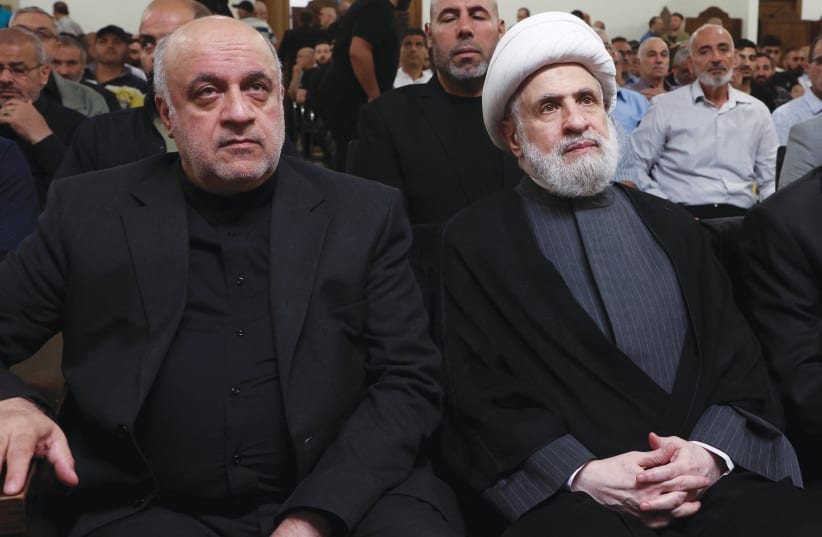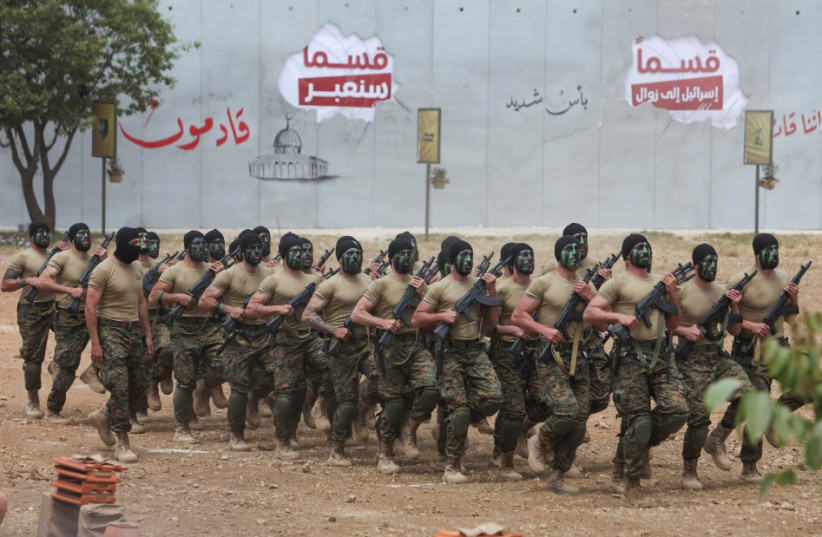Ever since October 7, Hezbollah, egged on by Iran, has been escalating its cross-border clashes with Israel, while its leader Hassan Nasrallah has been stepping up his blood-curdling rhetoric, predicting Armageddon if Israel were to launch an all-out war.
Yet the truth is that Iran-Hezbollah would like nothing better. They have sound strategic reasons for not initiating formal armed conflict. So their tactic has been to ramp up the provocation, daring Israel to strike back and trigger war.
Iran learned a lesson from its abortive attempt at overwhelming Israel’s defenses on April 13. In its first-ever direct aerial assault, it sent some 170 drones, over 30 cruise missiles, and more than 120 ballistic missiles 1,000 km. toward Israel. The Iranian leadership no doubt expected a massive military and propaganda triumph.
The operation was a miserable failure. To supplement Israel’s Iron Dome defense, America and Britain sent jet fighters to help shoot down the missiles. Jordan refused to allow Iran to use its air space for the operation, while several Gulf states, among them Saudi Arabia and the United Arab Emirates, passed on intelligence about Iran’s plans.
As a result, about 99% of the aerial armada never reached Israel, and Iran learned that not only the West, but much of the Middle East disliked and distrusted it.
Fearing wholesale lack of support if any formal Hezbollah-Israel conflict were seen as Iran-instigated, Iran-Hezbollah has, in the words of the English poet, Alexander Pope, been “willing to wound and yet afraid to strike.”
ON JUNE 18 the IDF announced that a plan for an offensive to push Hezbollah further back from the border had been approved, but that a diplomatic solution was still the preferred option.
The next day Nasrallah gave a televised address lasting more than an hour.
In previous wars with Israel, he said, Hezbollah had only hoped to be able to strike Israel’s Meron air base. Now, he claimed, the whole of Israel was within its range.
“And it won’t be random bombardment,” he threatened. “Every drone will have a target. Every missile will have a target.”
Boasting that Hezbollah had a large stockpile of drones, a “surplus of fighters” and unspecified “new weapons” that would be unveiled in due course, he said Hezbollah was manufacturing military weaponry in Lebanon and, despite Israel’s attacks on weapon-carrying convoys in Syria, had continued to receive weapons from Iran.
This, at least, was confirmed by the UK’s Daily Telegraph which, on June 23, reported that weapons are being flown from Iran into Lebanon and stored at Beirut’s main airport. The Telegraph based its report on whistleblowers at the airport who claim to have observed a marked increase in the arrival of weapons and also the presence of more Hezbollah commanders on the ground. The whistleblowers claim the operation has been escalating since the intensification of cross-border conflict between Hezbollah and Israel post-October 7.
The report claimed that currently, the cache of stored weapons includes Iranian-made Falaq unguided artillery rockets, Fateh-110 short-range missiles, road-mobile ballistic missiles, and M-600 missiles with ranges of 240 to 320 km. Also at the airport, it is claimed that there are AT-14 Kornets, laser-guided anti-tank guided missiles (ATGM), huge quantities of Burkan short-range ballistic missiles, and explosive RDX, a toxic white powder also known as cyclonite or hexogen.
The allegations will raise fears within Lebanon that, in the event of war, the Rafic Hariri airport, just four miles from the city center, could become a major military target.
Staff at the airport claim that Wafiq Safa, Hezbollah’s second in command and the head of its security apparatus, has become a notoriously conspicuous figure at the airport.
“Wafiq Safa is always showing up at customs,” one whistleblower claimed. Workers collaborating with Hezbollah, he said, “walk around like peacocks” with new watches and smartphones, and drive new cars. “A lot of money [is] being passed under the table.”
Ghassan Hasbani, the former deputy prime minister and an MP for the Lebanese Forces party, said Hezbollah’s control of the airport has long been a concern for Lebanon, and more so if it becomes a potential military target in a conflict with Israel.
“Weapons being transported from Iran to Hezbollah across border entry points, endangers both the Lebanese population and the non-Lebanese traveling through and living in the country,” he said.
Taking action, he said, is all but impossible without international intervention to implement relevant UN resolutions. “The entrenchment of Hezbollah is everywhere, not only in the airport but in the port, the judiciary; it’s across society. The public administration now is largely hijacked by Hezbollah.”
Ali Hamieh, Lebanon’s transportation minister, said the allegations were “ridiculous” and invited journalists and ambassadors to visit the airport. Hamieh, who was nominated to the government by Hezbollah, in fact, exemplifies the straits to which the once-independent sovereign state of Lebanon has been reduced. Hezbollah has acquired an iron grip on the levers of power and, in the process, reduced the nation to penury and political deadlock.
Hezbollah blocking political stability in Lebanon
LEBANON HAS been without a president since October 2022, with every possible nominee blocked by Hezbollah and its political allies. Moreover, compounded by widespread government corruption, the country is experiencing the worst financial crisis in its history.
After Prime Minister Najib Mikati announced in March 2020 that Lebanon would default on its Eurobond debt, the Lebanese currency began to plummet, leading to hyperinflation. In April 2023, Lebanese inflation hit a high of almost 270%. It has taken a year to bring the level down to around 52%, which still means unsustainable price increases for ordinary citizens, many of whom have become virtual paupers.
A further destabilizing factor is the huge refugee burden imposed on the country by the civil conflict in Syria. Lebanon maintains one of the largest refugee populations per capita in the world – more than 1.5 million, many of them Syrian.
Yet Lebanon, overwhelmed with domestic problems, is faced with the prospect of being dragged into Iran-Hezbollah’s ideological conflict with Israel, and potentially suffering bombardment, destruction, casualties, and deaths.
The people of Lebanon resented their sons being recruited by Hezbollah and sent to Syria to support its president, Bashar Assad, in his fight against his democratic opponents. How much more would they oppose a call by Nasrallah to take up arms against Israel? This is why Nasrallah refrains from taking the decisive step, and would much prefer to point to Israel as the instigator of the conflict.
The writer is the Middle East correspondent for Eurasia Review. His latest book is Trump and the Holy Land: 2016-2020. Follow him at www.a-mid-east-journal.blogspot.com.

